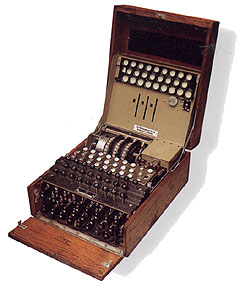|
Machine
intelligence (MI) is a term used to encompass artificial
intelligence (AI) and robotics.
AI research began after World War II. Alan
Turing, an English mathematician, gave a lecture on
AI in 1947. He suggested that programming was the
most suitable way to investigate AI.
In
1950, Turing asked the question: 'Can a machine think?'
To answer this, he proposed what became known as the
'Turing test' for artificial intelligence, which is
based on the ability of a computer to understand language.
The
Loebner
prize is a contest based upon the principles of
what constituted AI outlined by Alan Turing and is
conducted annually.
|

Enigma
cipher machine. This Enigma field type ciphering machine
was made in Germany in the 1940s and used by the German
Army in World War II to encipher and decipher military
information. Powerhouse Museum collection.
|
AI
research
Research into AI is aimed at building machines that demonstrate
behaviour that would normally require human intelligence.
Some researchers are even seeking to achieve machine consciousness.
So is AI about thinking, or is it about behaviour? This
question goes to the heart of both intelligence and consciousness.
Scientists, philosophers, linguists and theologians have
all contributed to ongoing research into AI.
AI
researchers need to understand the nature of intelligence.
Research over the past 50 years has demonstrated that human
intelligence is far more complex than anticipated.
Activity
Chatterbots are computer programs on the Internet that appear
to respond to questions and conversation. Visit a chatterbot
http://www.simonlaven.com
and 'talk' to a computer.
Human
intelligence
Some AI researchers believe that human intelligence and
consciousness derive from 'mechanical' and chemical factors
in the brain. They argue that if we can reproduce these
factors, we can 'create' AI. Others argue that true consciousness
will never be possible, but that sufficiently complex programs
will allow an effective simulation of human intelligence.
A third school of thought holds that 'intelligence' will
never be possible, only extremely rapid manipulation of
data.
Until
the 1970s, AI research focused on visual perception, understanding
language and general problem solving. Attention then turned
to developing knowledge and understanding within restricted
fields, trying to imitate the data-handling processes of
the human brain. This led to the development of neural nets,
'expert systems' and computer systems that accumulate knowledge
to 'learn' tasks.
 |
Imitating
learning
Some current AI research is trying to imitate the
learning process, where trial and error contribute
to the accumulation of knowledge and experience.
Stumpy
(the robot pictured) was developed by the University
of NSW. It may look a bit less sophisticated than
an Aibo, with wires hanging out and a mouse dragging
along behind it, but it is actually a lot more 'intelligent'.
|
Stumpy was originally given very simple instructions
— principally that it should move towards a light.
Through trial and error Stumpy, slowly learned to use
its legs, with the mouse registering when it was moving
forward. Through all its manoeuvring, Stumpy accumulates
knowledge of successful strategies and learns to move
forward. |
Cog
from the MIT Robotics Laboratory, is designed to interact
with people. Its 'facial features' mimic emotions to encourage
feedback, helping it to learn like a child, through experience-based
discovery.
For
more information on artificial intelligence visit the American
Association for AI (AAAI) site.
|